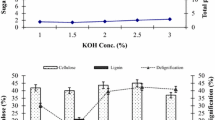Anstract
Effect of NaOH pretreatment on the biodegradation of corn cobs for the production of cellulase and protein was studied usingAspergillus niger. Delignification of cobs with NaOH remarkaby increased the production of cellulase and protein. Treatment of cobs with 2% NaOH was found to be the best with respect to their susceptibility to biodegradation for maximum production of cellulose 1,4-β-cellobiosidase, cellulase, β-glucosidase soluble protein and crude protein; this also led to the highest protein recovery, maximum cellulose utilization and also for the maximum degradation of substrate.
Similar content being viewed by others
References
A.O.A.C.:Official Methods of Analysis, 11th edn. Washington (DC) 1970.
Crawford R.L.:Lignin Biodegradation and Transformation. John Wiley and Sons, New York 1981.
Detroy R.W., Lindenfelser L.A., Julian J.R., Orton W.L.: Saccharification of wheat straw cellulose by enzymatic hydrolysis following fermentative and chemical pretreatment.Biotechnol. Bioeng. Symp.10, 135 (1980).
Fan L.T., Lee Y.H., Gharpuray M.M.: The nature of lignocellulosics and their pretreatments for enzymatic hydrolysis.Adv. Biochem. Eng.23, 157 (1982).
Flickinger M.C.: Current biological research on conversion of cellulosic carbohydrates into liquid fuels: how far have we come?Biotechnol. Bioeng.22 (Suppl. 1), 22 (1980).
Garg S.K., Neelkantan S.: Production of SCP and cellulose byAspergillus terreus from bagasse substrate.Biotechnol. Bioeng.24, 2407 (1982).
Gupta V.K., Prasad K.S., Bakshi M.P.S., Langar P.N.: Improving nutritive value of groundnut shells through fungal cultivation.Agric. Wastes16, 161 (1986).
Gupta J.K., Sharikot C.K., Dhawan S.: Growth of bacteria and yeast on enzymatically degraded alkali-treated rice and wheat straw.Acta Microbiol. Acad. Sci. Hung.28, 131 (1981).
Hatakka A.I., Pirhonen T.I.: Cultivation of wood rotting fungi on agricultural lignocellulosic materials for the production of crude protein.Agric. Wastes12, 81 (1985).
Kahlon S.S.: SCP production byChaetomium cellulolyticum on treated waste cellulose.J. Res. Punjab Agric. Univ.23, 330 (1986).
Mandels M., Andreotti R., Roche C.: Measurement of saccharifying cellulase.Biotechnol. Bioeng. Symp.6, 21 (1976).
Mandels M., Weber J.: The production of cellulases, inCellulase and Their Applications (R.F. Gould, Ed.),Adv. Chem. Ser.95; American Chemical Society, Washington (DC) 1969.
Miller G.L.: Use of dinitrosalicylic acid reagent for determination of reducing sugar.Anal. Chem.31, 426 (1959).
Ranjhan S.K., Gopal Krishna:Manual for Nutrition Research, p. 105. Vikas Publ. House, New Delhi 1981.
Shewale J.G., Sadana J.C.: Cellulase and β-glucosidase production by a basidiomycete species.Can. J. Microbiol.24, 1204 (1978).
Singh A., Abidi A.B., Agrawal A.K., Darmwal N.S., Srivastava S.: Utilization of cellulosic substrate for the production of single cell protein and cellulase enzyme.Indian J. Biol. Res.6, 1 (1988).
Souza J., Furtado I.: Action of cellulases from fungus of marine origin in rice straw.Indian J. Microbiol.17, 194 (1977).
Tanaka M., Taniguchi M., Morita T., Matsuno R., Amikubo T.: Effect of chemical treatment on solubilization of crystalline cellulose and cellulosic wastes withPellicularia filamentosa cellulase.J. Ferment. Technol.57, 186 (1979).
Taniguchi M., Kometani Y., Tanaka M., Matsund R., Kamikubo T.: Production of single cell protein from enzymatic hydrolyzate of rice straw.Eur. J. Appl. Microbiol. Biotechnol.14, 74 (1982).
Tewari N.K., Marwaha S.S., Singh L.: Studies on improvement of bio-availability of cellulosic agricultural wastes.J. Res. Punjab Agric. Univ.24, 139 (1987).
Tutte J.:Plant Pathological Methods—Fungi and Bacteria, p. 239. Burgess Publ. Co., Minneapolis 1969.
Updegraff D.M.: Semi-micro determination of cellulose in biological materials.Anal. Biochem.32, 420 (1969).
Author information
Authors and Affiliations
Rights and permissions
About this article
Cite this article
Singh, A., Abidi, A.B., Agrawal, A.K. et al. Evaluation of alkali treatment for biodegradation of corn cobs byAspergillus niger . Folia Microbiol 34, 479–484 (1989). https://doi.org/10.1007/BF02814457
Received:
Issue Date:
DOI: https://doi.org/10.1007/BF02814457




